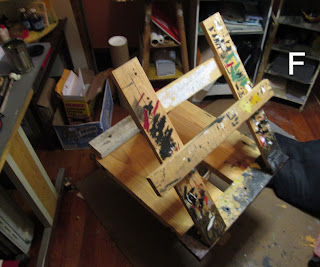Though self-published, this is a very rare book. A wide variety of readers may approach the content for distinctly different reasons. While the book appeals to me as a cartoonist, animal lovers will find much to savor, too. Though oblivious to the charms of cross hatching, they will ponder the plight of dogs living in a world run by hairless apes. Child readers will be intrigued by more than the doggie stuff, and rich details of a bygone era will certainly broaden their horizons. They may also notice that the children in these strips are often in alliance with animals against overbearing adults. And cultural aficionados justly deserve to have their snouts rubbed in the overt sentimentality--ranging from bathos to pathos--that drips from these enchanting pages, in order to remind them of the power of great cartooning.
The book also provides ample evidence of the changing social standards towards animal cruelty. A couple of cartoons feature boys entrusted with the task of killing unwanted litters of puppies and kittens. These days if a kid was caught red-handed throwing a potato sack of live kittens (plus rocks) into a creek he would doubtless be the grist for local evening news and would wind up in a psychiatrist’s office. Back in the era when these cartoons were done, such a heinous act would be seen merely as an unpleasant household chore to be done, lest a severe spanking be endured (which would also make today’s evening news and warrant psychological intervention).
The subtle emotional range dogs constantly exhibit in demeanor and posture are shown with the deft simplicity of masterful pen work by several great craftsmen of the early 20th century. As an added bonus there is a brief bio of each:
CLARE BRIGGS
H. T. WEBSTER
J. R. WILLIAMS
ED DODD
FRANK BECK
STANLEY LINK
The stunning back cover is done by FRANCES "EDWINA" DUMM
The images tend to be deceptively simple, but facial expressions and postures replicate life in a way that photographs rarely do. These are done with rapid line work that not only respects each animal; newspaper deadlines also had to be respected. This exquisite gallery of cartoons is a testimony to artistic grace under pressure. It's hard to believe that newspapers were once almost twice the size of what they are now. This scale permitted fine detail work and substantive text that readers came to expect for the few pennies they paid. When television replaced print as the main source of news, shrinking advertising income led to cost-cutting measures such as reduced page count and smaller page dimensions. The pared down cartoon format could no longer handle rich detail work so a minimal style driven by writing, not art, came to rule the day. The success of the main theme in most of these drawings--the plight of the dog in the world of man--is dependent on the generous scale of the background. There is great artistry involved in creating backgrounds that dramatize without dominating the human and canine subjects. Other than Bill Griffith's "Zippy" I can't think of any regular feature today that is staged with such lush tonal patterns, deep perspective space with full figures on a ground plane--crafted with traditional dip pens.
In his introductory pages, Bruce explains the genesis of the project and his motivation for seeing it thorough. He also looks back at a lifetime of scissoring cartoons from newspapers and archiving them in scrapbooks. These will eventually be sent to the world famous Billy Ireland Cartoon Museum at Ohio State University. His appreciation for the art form is met with equal fervor by his compassion for animals. His statement epitomizes both subjects:
"These cartoonists, famous for their ability to observe and convey the everyday humor of domestic life, childhood and the human condition tried, with these bleak looks at helplessness that met with indifference and abandonment, to open the hearts of their readership to needs beyond their own, and that is something unique in my lifetime study of the form."
There is a delightful drawing by Carol Lay on the title page and Noah Van Sciver did a colorized version of an H T. Webster panel for the cover. HIs palette nicely conveys the somber subject matter from which the book's title is taken: A dejected pooch, a trusting creature of habit, lingers outside the gate of an empty house.
By purchasing a book for a mere $10, you are contributing that full amount to the Muttville Senior Dog Rescue in San Francisco. Bruce Simon will handle out-of-pocket the printing, shipping and handling. A Paypal can be sent to kinevideo@aol.com or you could contact him there and get his mailing address if you'd prefer to send a check. Muttville (founded in '07) has been recognized for its groundbreaking approach to animal rescue. It's cage-free facility, focusing on foster outreach, has an on-site veterinary suite and its hospice program are wonderful innovations that have been lauded and emulated around the country. Cartoonists: Please don't try to short the IRS by claiming this book as both charitable giving and then do some sneaky double-dipping by also listing it as a deduction for printed materials (to which you are annually entitled).
The technical quality of self-publishing is now on par with the highest standards of trade press production. There is something to be said for this direct relationship with the final book, especially in reducing waste, as each order is filled and mailed on a per unit basis. Of course, it's very time consuming and frustrating to hawk your own wares. But let's face it, very few of us are able to scratch a living from this arcane field. When you are motivated by love, such concerns are incidental. A steady one permeates every page of this little volume.



























